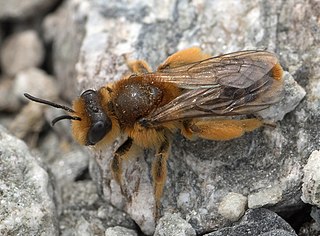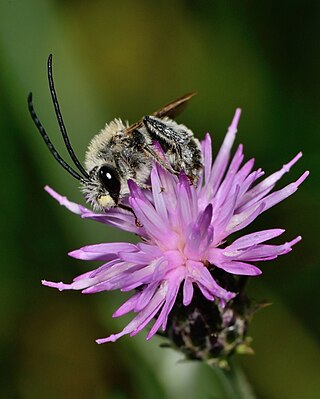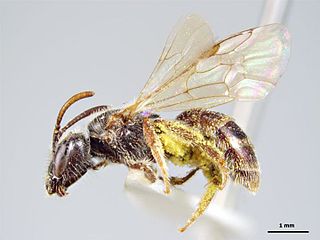
Megachilidae is a cosmopolitan family of mostly solitary bees. Characteristic traits of this family are the restriction of their pollen-carrying structure to the ventral surface of the abdomen, and their typically elongated labrum. Megachilid genera are most commonly known as mason bees and leafcutter bees, reflecting the materials from which they build their nest cells ; a few collect plant or animal hairs and fibers, and are called carder bees, while others use plant resins in nest construction and are correspondingly called resin bees. All species feed on nectar and pollen, but a few are kleptoparasites, feeding on pollen collected by other megachilid bees. Parasitic species do not possess scopae. The motion of Megachilidae in the reproductive structures of flowers is energetic and swimming-like; this agitation releases large amounts of pollen.

Mason bee is a name now commonly used for species of bees in the genus Osmia, of the family Megachilidae. Mason bees are named for their habit of using mud or other "masonry" products in constructing their nests, which are made in naturally occurring gaps such as between cracks in stones or other small dark cavities. When available, some species preferentially use hollow stems or holes in wood made by wood-boring insects.

Hylaeus is a large and diverse cosmopolitan genus within the bee family Colletidae. This genus is also known as the yellow-faced bees or masked bees. This genus is the only truly globally distributed colletid, occurring on all continents except Antarctica.

Habropoda laboriosa, the southeastern blueberry bee, is a bee in the family Apidae. It is native to the eastern United States. It is regarded as the most efficient pollinator of southern rabbiteye blueberries, because the flowers require buzz pollination, and H. laboriosa is one of the few bees that exhibit this behavior. It is active for only a few weeks of the year, while the blueberries are in flower during early spring, when the temperature is warm and humid. H. laboriosa are solitary bees that live alone but nest in close proximity with other nests of their species. They have similar features to bumble bees, but they are smaller in size compared to them. H. laboriosa are arthropods so they have segmented bodies that are composed of the head, thorax, and abdomen.

Leioproctus, the hairy colletid bee, is a genus in the plaster bee family Colletidae. Its members are primarily found in Australasia and temperate South America, and include the most common native bees in New Zealand.

Osmia bicornis is a species of mason bee, and is known as the red mason bee due to its covering of dense gingery hair. It is a solitary bee that nests in holes or stems and is polylectic, meaning it forages pollen from various different flowering plants. These bees can be seen aggregating together and nests in preexisting hollows, choosing not to excavate their own. These bees are not aggressive; they will only sting if handled very roughly and are safe to be closely observed by children. Females only mate once, usually with closely related males. Further, females can determine the sex ratio of their offspring based on their body size, where larger females will invest more in diploid females eggs than small bees. These bees also have trichromatic colour vision and are important pollinators in agriculture.

Anthidium manicatum, commonly called the European wool carder bee, is a species of bee in the family Megachilidae, the leaf-cutter bees or mason bees.

Eucera is a genus of bees in the family Apidae, which comprises more than 100 species. These bees are commonly known as long-horned bees due to their characteristically long antennae, especially in males. Eucera species can be found in diverse habitats, including meadows, fields, and urban gardens, primarily in the Palearctic and Nearctic regions, covering parts of Europe, Asia, North Africa, and North America.

Peponapis pruinosa is a species of solitary bee in the tribe Eucerini, the long-horned bees. Its common name is the eastern cucurbit bee. It may be called the squash bee, but this name can also apply to other species in its genus, as well as the other squash bee genus, Xenoglossa. This bee occurs in North America from the East Coast of the United States to the West Coast and into Mexico. It is an oligolege, specializing on a few host plants, the squashes and gourds of genus Cucurbita. Its range expanded as human agriculture spread throughout North America and squash plants became more abundant and widespread. It may also have spread naturally as the range of its favored wild host plant Cucurbita foetidissima expanded.

Leioproctus fulvescens is a species of solitary bee belonging to the family Colletidae. This bee is endemic to the South Island of New Zealand, and its yellow-orange hair distinguishes it from all other New Zealand species of Leioproctus.

Ptilothrix is a genus within the tribe Emphorini of the family Apidae. Bees of this genus can range from 7 to 15 mm. Ptilothrix species are solitary, ground-nesting bees. These bees have especially prominent hairs in the scopae of their hind legs, to help gather pollen to provision their nests. Ptilothrix species specialize on certain families of plants for their pollen, including the families Malvaceae, Convolvulaceae, Onagraceae, Cactaceae, Pontederiaceae, and Asteraceae. The genus is found in the New World, with species ranging across the Americas.

Macropis nuda is a ground nesting, univoltine bee native to northern parts of North America. Thus, this species cocoons as pupae and hibernates over the winter. The species is unusual as it is an oligolectic bee, foraging exclusively for floral oils and pollen from Primulaceae of the species Lysimachia ciliata.

Hylaeus agilis is a bee species in the family Colletidae. It is endemic to New Zealand. This species is found throughout the country and visits the flowers of a wide variety of plant species, both native and introduced.

Colletes validus, colloquially known as the blueberry cellophane bee, is a solitary, specialist bee in the family Colletidae. It is found primarily in eastern North America where it nests in sandy soils near ericaceous plants.

Lasioglossum sordidum, also referred to as the small native bee, is one of the smallest native bees found in New Zealand.

Lasioglossum mataroa is a bee species that is found in New Zealand.

Leioproctus boltoni is a species of bee in the family of plasterer bees. This species was first described in 1904 and is endemic to New Zealand. They are a solitary bee, small and black in appearance. L. boltoni can be found throughout the main islands of New Zealand and forages on the flowers of both native and introduced species of plants. This species nests in the soil with their life cycle lasting approximately a year.
Leioproctus huakiwi is a species of bee in the family Colletidae family. This species was first described in 2007 and is endemic to New Zealand. L. huakiwi is a solitary bee, small and mainly black in appearance. It nests in the ground in bare, dry and fine soil. This species has been the subject of a successful translocation in Canterbury in 2005.

Centris analis is a solitary, oil-collecting bee with a geographical range extending from Brazil to Mexico. C. analis is a small, fast-flying bee with an average head width of 3.21mm and 3.54mm for males and females, respectively. While most species of the genus Centris create burrows for nesting, C. analis and other species of the subgenus Heterocentris build nests in pre-existing cavities rather than in the ground. C. analis is a pollinator of many plant species, especially of those in the family Malpighiaceae, which has encouraged its application in acerola orchards.

Leioproctus imitatus is a species of plaster bee in the family Colletidae. It is a small, black, solitary bee that is endemic to New Zealand.

















